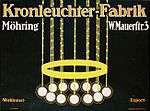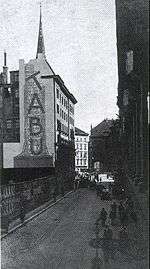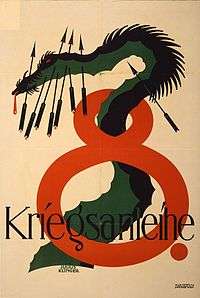Julius Klinger
Julius Klinger (May 22, 1876 – 1942) was an Austrian Painter, draftsman, illustrator, commercial graphic artist, typographer and writer. Klinger studied at the Technologisches Gewerbemuseum in Vienna.[1]
Early works in Vienna and Munich

Klinger was born in Dornbach near Vienna. In 1895, he found his first employment with the Vienna fashion magazine Wiener Mode. Here he made acquaintance with Koloman Moser, who later would be his teacher; Moser recommended him to the Meggendorfer-Blätter.[2]
1896 saw him moving to Munich where he worked as an illustrator for the Meggendorfer-Blätter[3] and others. From 1897 to 1902 he was a collaborator to the eponymous Jugendstil magazine Die Jugend.
Berlin

In 1897 he relocated to Berlin, where he worked extensively as a commercial graphic artist until 1915. Together with the printing house Hollerbaum und Schmidt, he developed a new fashion of functional poster design that soon gained him international reputation.[2] In 1912 he designed the poster for the Rund um Berlin air show in Johannisthal. In Berlin he also contributed to Das kleine Witzblatt, Lustige Blätter and Das Narrenschiff humorous magazines.
Advertising campaign for the "Tabu" company

Beginning in 1918, Klinger designed a comprehensive and noted campaign promoting the "Tabu" company's cigarette rolling paper, that was advertised all over Vienna in 1918/19. Klinger devised a promotional strategy, spanning from small-sized newspaper advertisements to billboards and painted firewalls – construction site fences and winterized fountain paneling were used as advertising space, too.[4]
Nazi persecution

Being of Jewish descent, he suffered from national socialist harassment. According to Viennese police records, he was registered as moved to Minsk on June 2, 1942, i.e. deported. Presumably, he was killed the same year.[2]
Probably towards the end of 1937 he designed his last poster for the Ankerbrot-Werke factory. The Jewish-owned company was transferred to "Aryan" proprietors in 1938; after 1945 legitimate ownership was restored.
Literature
- Anita Kühnel: Julius Klinger – Bilderheft der Staatlichen Museen zu Berlin (Catalogue of the Berlin State Museums), Gebr. Mann, Berlin, 1999
Some of his work
-
B/W drawing circa 1907/1908.
-
Werbung (1919). -

Poster for 8e war loan, Austria-Hungary (1918). -

Aéroport Johannisthal de Berlin (1908). -
Cravates Hermanns & Froitzheim (1910). -
Poster for "Tabu"-cigarette paper.
-
 Poster for "Elida" toilet soap, 1921.
Poster for "Elida" toilet soap, 1921. -
Foire de Vienne (1922). -
Lame de rasoir du viennois M. E. Mayer (1922). -
Poster of the Viennese perfume company Pessl (1923).
External links
- Dr.Wiles-Worris – Weil's woah is, Der Standard, 12. November 1999
- Anita Kühnel: Julius Klinger – Poster Artist and Draftsman
Notes
- ↑ Austrian AEIOU Encyclopedia
- 1 2 3 Julius Klinger (Wien 22. 5. 1976-1942?), biographical entry with the Austrian National Library
- ↑ David Ciarlo (January 2011). Advertising Empire. Harvard University Press. p. 292. ISBN 978-0-674-05006-8. Retrieved 4 September 2016.
- ↑ Plakat: Julius Klinger: Tabu, 1919, Austrian National Library, 2003